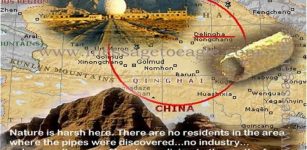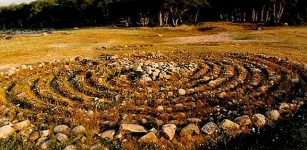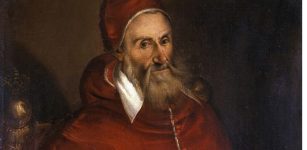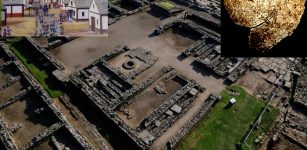Meidum ‘Collapsed’ Pyramid Of Great Builder Pharaoh Snefru
A. Sutherland - AncientPages.com - Pharaoh Snefru (Sneferu) was the founder of the 4th dynasty during the Old Kingdom.
Snefru is considered the greatest builder in Egyptian history, who reigned from around 2613 BC to 2589 BC, according to Manetho, an Egyptian priest, living in the third century BC.

Some suggest the pyramid not to have collapsed until the New Kingdom, but there are a number of facts contradicting this theory. The Meidum Pyramid seems never to have been completed.
He built at least three pyramids that survive to this day and is also contributed with several innovations regarding design and construction of pyramids in ancient Egypt.
Snefru was born and grew up in the royal palace in Memphis, not far from modern city of Cairo. His father was King Huni, who was the last pharaoh of the Third Dynasty and his mother was a royal princess, Meresankh. It is believed she was Huni's sister.
Pharaohs were often wed to their sisters and it was nothing unusual in this ancient Egyptian tradition.
Snefru was the father of Khufu (2589-2566 BC), the 4th Dynasty Pharaoh who ruled during the first half of the Old Kingdom period. Khufu is widely accepted as the ruler who commissioned the Great
Pyramid of Giza, one of the Seven Wonders of the World.
These pyramids are the Red Pyramid, the Bent Pyramid, and the third one, Meidum Pyramid (also known as the ‘Collapsed' Pyramid. Inside the Bent Pyramid, an inscription with Snefru's name and a stela discovered by archaeologists alongside the neighboring, subsidiary pyramid shows Snofru himself.)
 Despite the fact that a last ruler of the Dynasty III, pharaoh Huni and father of Snefru, erected the Meidum Pyramid, the structure was definitely completed by Snefru, most probably after his father’s death.
Despite the fact that a last ruler of the Dynasty III, pharaoh Huni and father of Snefru, erected the Meidum Pyramid, the structure was definitely completed by Snefru, most probably after his father’s death.
A Middle Kingdom papyrus recorded:
"The Majesty of King Huni died, and the Majesty of King Snofru was raised up as a benevolent King in this entire land."
The Meidum Pyramid can be found approximately 62 miles (100 km) south of modern Cairo 30 miles (48 km) south of Memphis.
It was 93m high and built with a 114m long square base. Its entrance, built about 30m above ground level, in the pyramid’s northern face, leads to a corridor descending for 54 meters. In its final form the structure stood about 311ft (95m) high.
The structure seems to have been planned to be a stepped pyramid, and its central square had to form both the nucleus and peak of the pyramid. Around it the builders added a succession of six layers around it, of which each was sloping at an angle of 75 degrees towards the structure's core. All layers were covered with white limestone, however, the last layer, therefore, rested not on solid rock but rather on three layers of limestone blocks and sand.

Left: Snefru, 1st King of Egypt's 4th Dynasty; Right: Stela depicting 4th Dynasty King Snofru. IMage via bbc.co.uk
The pyramid became unstable. Its heavy outer layers were completely ruined in antiquity. It is not exactly known when in antiquity this collapse happened. It is believed that the structure at least partially collapsed by the time of the New Kingdom, around 1550 BC.
See also:
Sobek - Enigmatic Crocodile God of Ancient Egypt
Ancient Egyptian Capital Tell El-Amarna Mapped Through Satellite Imagery System
Interesting Ancient Civilizations
What is important is, this pyramid-like structure seems never to have been completed.
For example, the mortuary temple, located under the rubble at the base of the pyramid, in fact, never was finished. Archaeologists have discovered that the temple’s two steles without inscriptions and the burial chamber inside the pyramid itself, has never been completed. Also wooden supports – usually removed after construction - have been found still in place.
Today, the Meidum 'Collapsed' Pyramid hardly resembles a pyramid.
Written by – A. Sutherland - AncientPages.com Senior Staff Writer
Copyright © AncientPages.com All rights reserved. This material may not be published, broadcast, rewritten or redistributed in whole or part without the express written permission of AncientPages.com
Expand for referencesMore From Ancient Pages
-
 Kingdom Of Nubia: Pyramids And Priceless Secrets Of A Civilization Forgotten Long Time Ago
Civilizations | Feb 13, 2018
Kingdom Of Nubia: Pyramids And Priceless Secrets Of A Civilization Forgotten Long Time Ago
Civilizations | Feb 13, 2018 -
 A 2,000-Year-Old Tomb Of A Roman Physician And His Medical Instruments Found In Hungary
Archaeology | May 2, 2023
A 2,000-Year-Old Tomb Of A Roman Physician And His Medical Instruments Found In Hungary
Archaeology | May 2, 2023 -
 ‘Vandal’ Of Norwegian Viking Graves Identified But Charges Have Been Dropped!
Archaeology | Nov 9, 2020
‘Vandal’ Of Norwegian Viking Graves Identified But Charges Have Been Dropped!
Archaeology | Nov 9, 2020 -
 Mysterious Artifacts Scattered Around Mount Baigong, China
News | Jun 23, 2014
Mysterious Artifacts Scattered Around Mount Baigong, China
News | Jun 23, 2014 -
 Galileo Galilei Wrote A Controversial Astronomical Treatise Using A Pseudonym
News | Oct 6, 2022
Galileo Galilei Wrote A Controversial Astronomical Treatise Using A Pseudonym
News | Oct 6, 2022 -
 Tomb of Patriarchs In Hebron Was Used And Visited By Pilgrims 2,700 Years Ago – New Study
Archaeology | Jul 10, 2020
Tomb of Patriarchs In Hebron Was Used And Visited By Pilgrims 2,700 Years Ago – New Study
Archaeology | Jul 10, 2020 -
 Viking Treasures Discovered In Chamber Grave In Denmark
Archaeology | Apr 4, 2014
Viking Treasures Discovered In Chamber Grave In Denmark
Archaeology | Apr 4, 2014 -
 Secrets Of Bolshoi Zayatsky Island – Mysterious Stone Labyrinths Of Unknown Purpose And Origin
Featured Stories | Oct 21, 2014
Secrets Of Bolshoi Zayatsky Island – Mysterious Stone Labyrinths Of Unknown Purpose And Origin
Featured Stories | Oct 21, 2014 -
 Adorable Village Of The Little People In Connecticut
Featured Stories | Jul 25, 2019
Adorable Village Of The Little People In Connecticut
Featured Stories | Jul 25, 2019 -
 First Genetic Map Of People Of Ireland Is Presented By Irish, British And American Researchers
Archaeology | Dec 15, 2017
First Genetic Map Of People Of Ireland Is Presented By Irish, British And American Researchers
Archaeology | Dec 15, 2017 -
 Why Napoleon’s Invasion Of Russia Was A Fiasco
Ancient History Facts | Mar 31, 2017
Why Napoleon’s Invasion Of Russia Was A Fiasco
Ancient History Facts | Mar 31, 2017 -
 Once Looted Nearly 1,000-Year-Old Maya Text Is Authentic – Mexican Experts Say
Archaeology | Sep 1, 2018
Once Looted Nearly 1,000-Year-Old Maya Text Is Authentic – Mexican Experts Say
Archaeology | Sep 1, 2018 -
 On This Day In History: The Gregorian Calendar Implemented – On Oct 5, 1582
News | Oct 5, 2016
On This Day In History: The Gregorian Calendar Implemented – On Oct 5, 1582
News | Oct 5, 2016 -
 1,400-Year-Old Christian Chalice With Etched Symbols Found In Rubble At Vindolanda Fort, Britain
Artifacts | Sep 1, 2020
1,400-Year-Old Christian Chalice With Etched Symbols Found In Rubble At Vindolanda Fort, Britain
Artifacts | Sep 1, 2020 -
 Iron Age Site Tell Deir ‘Alla (“Mound Of The High Monastery”) Flourished 400 Years In Central Jordan Valley
Archaeology | Jul 25, 2022
Iron Age Site Tell Deir ‘Alla (“Mound Of The High Monastery”) Flourished 400 Years In Central Jordan Valley
Archaeology | Jul 25, 2022 -
 5000-Year-Old Cold Case: Neolithic Fisherman Died By Drowning – Forensic Study Shows
Archaeology | Feb 14, 2022
5000-Year-Old Cold Case: Neolithic Fisherman Died By Drowning – Forensic Study Shows
Archaeology | Feb 14, 2022 -
 Peace Of Callias – A Treaty That Ended The Greco-Persian Wars
Ancient History Facts | May 15, 2019
Peace Of Callias – A Treaty That Ended The Greco-Persian Wars
Ancient History Facts | May 15, 2019 -
 Unique Find: Sacred Gate Found At The Minoan Palace Of Archanes In Crete
Archaeology | Nov 1, 2024
Unique Find: Sacred Gate Found At The Minoan Palace Of Archanes In Crete
Archaeology | Nov 1, 2024 -
 Susa: One Of The World’s Oldest Cities That Served As Capital Of The Elamite Empire
Featured Stories | Oct 14, 2023
Susa: One Of The World’s Oldest Cities That Served As Capital Of The Elamite Empire
Featured Stories | Oct 14, 2023 -
 Echo And Narcissus: Cursed Ability To Speak And Punishment Of Selfish Love And Vanity
Featured Stories | Feb 9, 2021
Echo And Narcissus: Cursed Ability To Speak And Punishment Of Selfish Love And Vanity
Featured Stories | Feb 9, 2021
